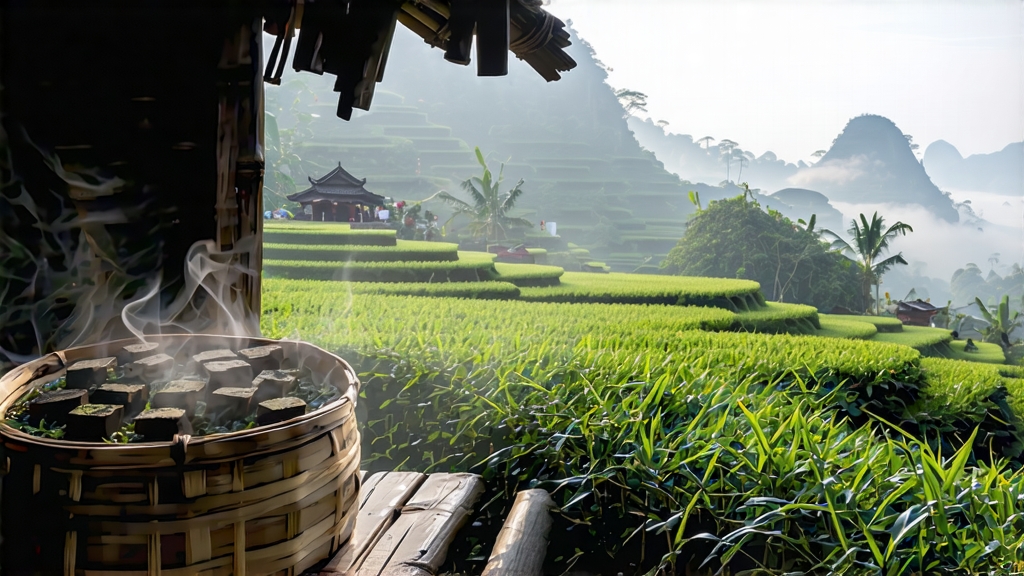
Tucked into the humid folds of southern China’s Guangxi Zhuang Autonomous Region, Liu Bao tea has spent four centuries quietly maturing in bamboo baskets, waiting for the world to notice. While Pu-erh has become the global shorthand for Chinese dark tea, Liu Bao is the older, subtler sibling—fermented, aged, and infused with the scent of camphor forests that cradle the small town of Wuzhou. To understand Liu Bao is to follow the ancient tea-horse caravan routes that once carried bricks of this ebony leaf from the Pearl River basin to the docks of Hong Kong and, eventually, to the dim-sum tables of Malaysia where it is still sipped between bites of steamed dumplings.
Historical records first name Liu Bao during the Ming Jiajing era (1522–1566), when local Tu ethnic chieftains offered it as tribute to the imperial court. The tea’s ability to calm stomachs after opulent banquets earned it the nickname “medicine tea,” a reputation that spread along the maritime Silk Road. By the late Qing, Liu Bao had become ballast in the holds of coolie ships sailing for Southeast Asia; the steady humidity of the cargo hold inadvertently accelerated its post-fermentation, creating the mellow, woody liquor that Malaysian tin-miners swore could prevent malaria. Thus a shipping accident became a house style, and Liu Bao’s identity was sealed: a tea that improves by being moved.
Strictly speaking, Liu Bao is a dark tea (hei cha), not a black tea (hong cha). After the leaves are picked from the Yunkai mountain strain—a large-leaf Assamica varietal that thrives in the red lateritic soil—they undergo a short outdoor withering under subtropical fog. The kill-green step is brief, just enough to halt oxidative enzymes while preserving leaf moisture for the crucial next phase: wet piling. Here Liu Bao diverges from Pu-erh. Instead of being piled on cement floors, the leaf is heaped inside bamboo steamers lined with rice straw. Hot water vapor is piped in, raising the heap temperature to 60 °C for six hours, then allowed to drop naturally. This cycle repeats for 18–25 days, during which Bacillus subtilis and Aspergillus niger bloom, breaking down cellulose into soluble sugars and releasing the trademark camphor-cedar bouquet. Once the master determines the core temperature has stabilized, the tea is pressed into 30 kg baskets woven from mature mao zhu bamboo; the bamboo’s residual moisture continues a micro-fermentation that can last decades.
Aging Liu Bao is a dialogue between tea and container. Traditional baskets are stored in riverside warehouses where night breezes carry the scent of sweet osmanthus; over years the tea absorbs these botanical notes, layering them atop its intrinsic earthiness. A 1980s basket recently opened in Kuala Lumpur emitted aromas of star anise, dried longan, and the faintest trace of petroleum—an olfactory postcard from the ship that once carried it. Connoisseurs classify Liu Bao into three stylistic eras: pre-1973 “raw” baskets that were never wet-piled, 1973–2003 state-factory bricks that were standardized at 1 kg for export, and post-2003 artisanal cakes that experiment with shorter piling to retain floral high notes. Each era demands its own brewing choreography.
To brew Liu Bao respectfully, begin by awakening the leaf. Pry 5 g from the basket using a blunt tea knife—never a sharp blade, which bruises the leaf and releases bitterness. Place the shards in a pre-warmed Yixing clay teapot of 120 ml capacity; the mineral-rich clay buffers the tea’s acidity and amplifies its bass tones. Flash-rinse with 100 °C water for three seconds, discard, then inhale the lid: you should smell wet bark, molasses, and the ghost of camphor. The first proper infusion lasts ten seconds; pour in a thin stream to aerate the liquor. Subsequent steeps lengthen by five-second increments. A well-aged Liu Bao will yield twelve infusions, each revealing a new stratum: dark cocoa, black cherry, tobacco, finally the sweet petrichor of summer rain on granite.
Tasting Liu Bao is best done in silence. Swirl the amber liquor—so dark it borders on ebony—against a white porcelain cup. Observe the “golden ring” halo that cl